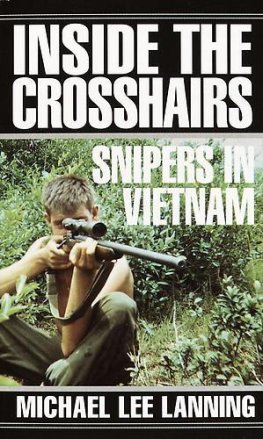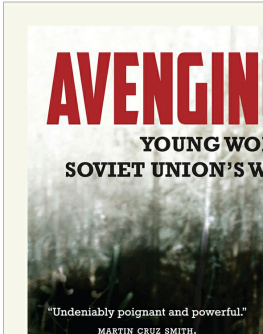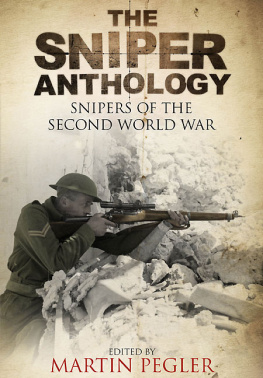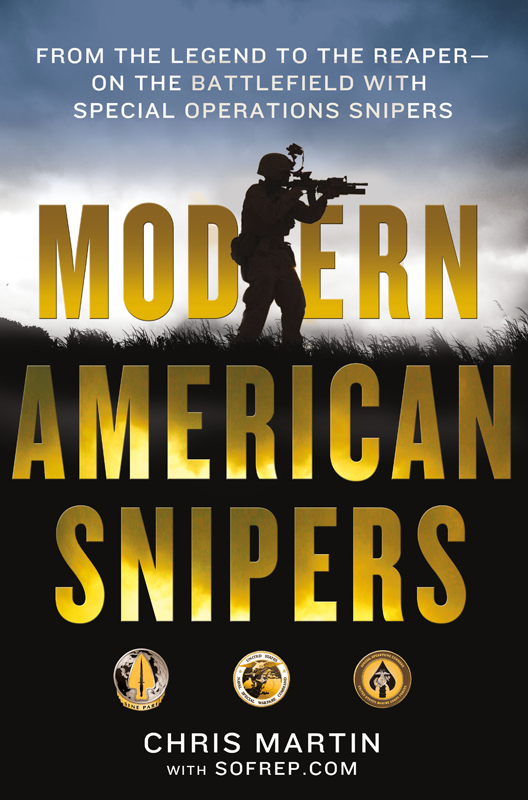Contents
Guide

The author and publisher have provided this e-book to you for your personal use only. You may not make this e-book publicly available in any way. Copyright infringement is against the law. If you believe the copy of this e-book you are reading infringes on the authors copyright, please notify the publisher at: us.macmillanusa.com/piracy.
Contents
Theres no doubt in my mind that American special operations has produced the finest and most technologically savvy snipers the worlds battlefields have ever seen. This book is a back window into some of the most accomplished marksmen deployed against Americas enemies.
I had the honor of serving as a Navy SEAL instructor at the Naval Special Warfare Group One sniper cell, and later at the Special Warfare Centers basic sniper course. The instructor cadre that I worked with at both units sacrificed long hours, and put their hearts and souls into the training in order to ensure that our guys were ready to deploy at the tip of the spear, and rain down hate on the enemy. These were some of the finest men Ive had the pleasure to work with in my career.
Outside of the schoolhouse we came to work with other units sniper instructors in different branches of the U.S. and coalition militaries. Always on the lookout to share ideas and improve our courses even more, we shared one thing in common, a desire to produce the best student possible. What this also did was let us get to know coalition programs, the USMCs Scout Sniper course (we even sent some SEALs there), and the Armys Special Operations Target Interdiction Course (SOTIC), and to know them with great respect and mutual admiration of the work we were all doing.
Reflecting back it was a rare moment in history and time. While most of the instructor cadre had real-world sniper experience, most of it was limited to doing airborne support or reconnaissance and aerial targeting. We had no idea that the men we were training, in our newly modernized sniper program, would go on to become some of the deadliest snipers the American military has ever produced. Guys like Chris Kyle ( American Sniper ), and Marcus Luttrell ( Lone Survivor ) would come through our schoolhouse, and go on to do different but great things in their own way. These men have been highlighted in the media but they would likely defer attention away from themselves and toward many of the other unknown snipers in the community that have equally incredible accomplishments against the enemies of America.
While Im admittedly biased to the product we put out in the SEAL sniper program, the accomplishments of the U.S. Special Operations Command (US SOCOM) sniper community cannot, and should not, go unknown. These are their stories. Whether it was Chris Kyle giving sniper support to the Marines in the hot and dirty streets of Iraq, or Nick The Reaper Irving providing sniper overwatch for the SEALs, one thing is clear to me: Its one team, one fight.
Eric Davis,
Former Navy SEAL Sniper Instructor
Some three hundred miles off the coast of Somalia in the dead of night, everything was black. Even the silhouettes of the hulking floating structures that surrounded their little vessel could not be made out against the sky behind themat least not well enough to discern that those shadows were growing larger.
The three remaining pirates had been playedconvinced it was in their best interest to accept a tow from the USS Bainbridge, the destroyer on point of the shepherding armada.
The enterprising teenagers were exhausted, weary, and growing increasingly agitated. Only a few days before, they had accomplished something no others had in nearly two centuries: the successful seizure of a United States Merchant Marine vessel.
The hijacking had not gone exactly to plan and now they found themselves in an awkward-looking lifeboat, cramped and breathing stale air. Their single source of leverage was the man who not long before was in charge of the cargo ship they had boardedCaptain Richard Phillips of the MV Maersk Alabama .
However, that bargaining chip was significant enough to prove considerably more than they had actually bargained for, bringing the maritime might of the United States Navy down on top of them. And that might was expressed not only by the mammoth naval destroyers, frigates, carriers, and aircraft those boats ferry.
Unbeknownst to the pirates, an advance team of DEVGRU operators had materialized on the scene, taking up station on the Bainbridge . The commandos had jumped in following a short flight from their operational base in Manda Bay, Kenya, and they were soon joined by a larger force that flew in from the States on a C-17 and also parachuted into the shark-infested waters of the Gulf of Aden.
Earlier there had been four pirates threatening the life of the captain on the lifeboat. But one, the wounded and desperate Abdiwali Abdiqadir Muse, had surrendered and voluntarily placed himself in the hands of the SEALs.
Despite its cramped quarters, the bobbing orange lifeboat had already been the backdrop for plenty of drama. Phillips attempted an ill-advised escape at one point but was fished back out of the water and yanked back into the craft.
Troublingly, Phillipss captors had grown more and more unpredictable as the days wore on. At times they would crack shots from their Kalashnikov rifles at the Navy ships, and at others they would communicate via satellite phone with potential reinforcements of their owna makeshift Somali pirate armada consisting of five additional hijacked ships loaded with additional hostages.
And almost comically, the pirates also provided occasional real-time updates to the international press corps as the world became entranced by the ratcheting drama.
The FBI negotiations cycled between promising and nonexistent. Lockheed P-3 Orion and Boeing ScanEagle ISR (intelligence, reconnaissance, and surveillance) platforms circled overhead while the DEVGRU assaulters readied on the USS Boxer , just waiting for the green light to launch.
For days the units snipersmembers of its shrouded Black Teamhad rotated through gun positions fanned out the back deck of the Bainbridge .
While waterborne operations are the historic calling card of Navy SEALs and maritime hostage rescues DEVGRUs raison dtre, the reality is that by April 12, 2009, these SEALs had spent nearly a decade dismantling terrorist networks in the jagged mountains of Afghanistan. Even the most senior of DEVGRUs men were far more familiar with operating at an elevation of ten thousand feet above the sea rather than in it; their particularly demanding tasking requires they be prepared for any mission, in any environment, at any time. And the more impossible its deemed, the more likely it will come their way.
The SEALs who had come to save the captive American hailed from Red Squadron, one of DEVGRUs four assault squadrons. It had shed blood in the region before. In 1993, four of its snipers had taken part in Operation Gothic Serpentmore popularly known as Black Hawk Downin Mogadishu, Somalia, in 1993 and earned four Silver Stars for their considerable trouble.
One of Red Squadrons own was also the first make the ultimate sacrifice following 9/11. Petty Officer First Class Neil Roberts died fighting alone atop the peak of Takur Ghar in Afghanistan during Operation Anaconda.
And over the decade following that loss, the squadron had doled out vengeance in spectacular numbers and with unapologetic efficiency.













